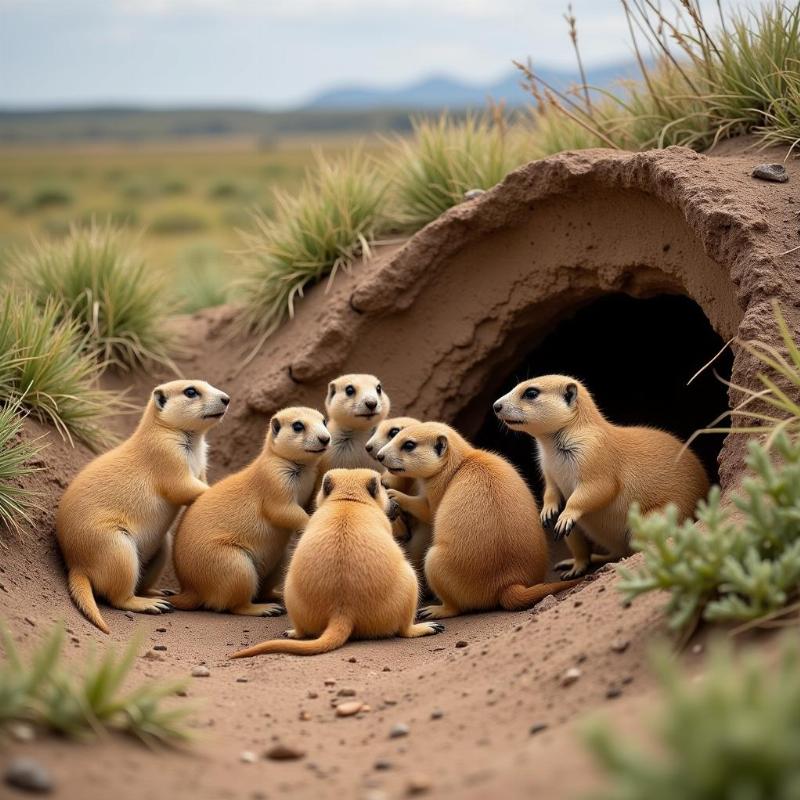Prairie dogs are iconic symbols of the American West, and New Mexico is home to thriving colonies of these charismatic rodents. Understanding their behavior, habitat, and the legal landscape surrounding them is crucial for anyone interested in observing or coexisting with these fascinating creatures. This article delves into the world of prairie dogs in New Mexico, offering valuable insights into their lives and how we can appreciate them responsibly.
Prairie dogs are highly social animals, living in complex underground burrow systems known as “towns.” These towns can span vast areas, providing shelter and protection for hundreds or even thousands of individuals. In New Mexico, the black-tailed prairie dog is the most common species. Their presence is vital to the ecosystem, as their burrows aerate the soil, promote plant diversity, and provide shelter for other animals. But what exactly is the status of prairie dogs in the Land of Enchantment? Let’s explore.
Understanding Prairie Dog Behavior and Habitat in New Mexico
Prairie dogs are diurnal, meaning they are most active during the day. They communicate with a complex series of barks, chirps, and whistles, alerting each other to potential dangers. Their diet consists primarily of grasses and forbs, and they play a crucial role in maintaining the health of grasslands. New Mexico’s diverse landscapes provide various habitats for these rodents, from shortgrass prairies to semi-desert areas.
Their burrows offer protection from predators such as coyotes, hawks, and badgers, and also provide a stable environment for raising their young. Understanding their habitat requirements is essential for conservation efforts.
The Legal Status of Prairie Dogs in New Mexico
While admired by many, prairie dogs can sometimes be perceived as pests, particularly by landowners concerned about potential damage to crops or grazing land. In New Mexico, prairie dogs are not classified as endangered or threatened, and their management is largely left to individual landowners. However, it’s important to be aware of local regulations and best practices for prairie dog management, especially if considering relocation or removal.
 Prairie Dog Family in New Mexico
Prairie Dog Family in New Mexico
It’s always advisable to consult with local wildlife officials before taking any action that may impact prairie dog populations.
Observing Prairie Dogs Responsibly
New Mexico offers numerous opportunities to observe prairie dogs in their natural environment. National parks, wildlife refuges, and even roadside areas can provide glimpses into their fascinating social interactions. When observing prairie dogs, it’s crucial to maintain a respectful distance and avoid disturbing their activities.
Never attempt to feed or handle prairie dogs, as this can disrupt their natural behavior and potentially transmit diseases. Responsible observation allows us to appreciate these creatures without interfering with their vital role in the ecosystem.
Conclusion
Prairie dogs are integral to New Mexico’s unique ecological tapestry. Understanding their behavior, habitat, and the legal considerations surrounding them is crucial for fostering coexistence. By respecting their space and observing them responsibly, we can continue to enjoy the presence of these charming rodents for generations to come. Remember to always check with local authorities for the most up-to-date regulations concerning prairie dogs in your area.
FAQ
- Are prairie dogs protected in New Mexico? While not federally protected, their management is subject to state and local regulations.
- What do prairie dogs eat? They primarily consume grasses and forbs.
- Where can I see prairie dogs in New Mexico? National parks, wildlife refuges, and even roadside areas can be good locations.
- Can I keep a prairie dog as a pet in New Mexico? Regulations vary, so it’s essential to research local laws and consider the ethical implications.
- What should I do if I have prairie dogs on my property? Contact local wildlife officials for guidance on appropriate management practices.
- How do prairie dogs communicate? They use a variety of barks, chirps, and whistles.
- What are the predators of prairie dogs? Coyotes, hawks, and badgers are among their primary predators.
Beautdogs.us is your premier source for all things dog-related in the United States. We offer expert advice on dog breeds, care, and products. Whether you’re a seasoned dog owner or just starting your journey, Beautdogs.us is here to help. Contact us at [email protected] or +1 501-555-7529 for all your dog-related needs.